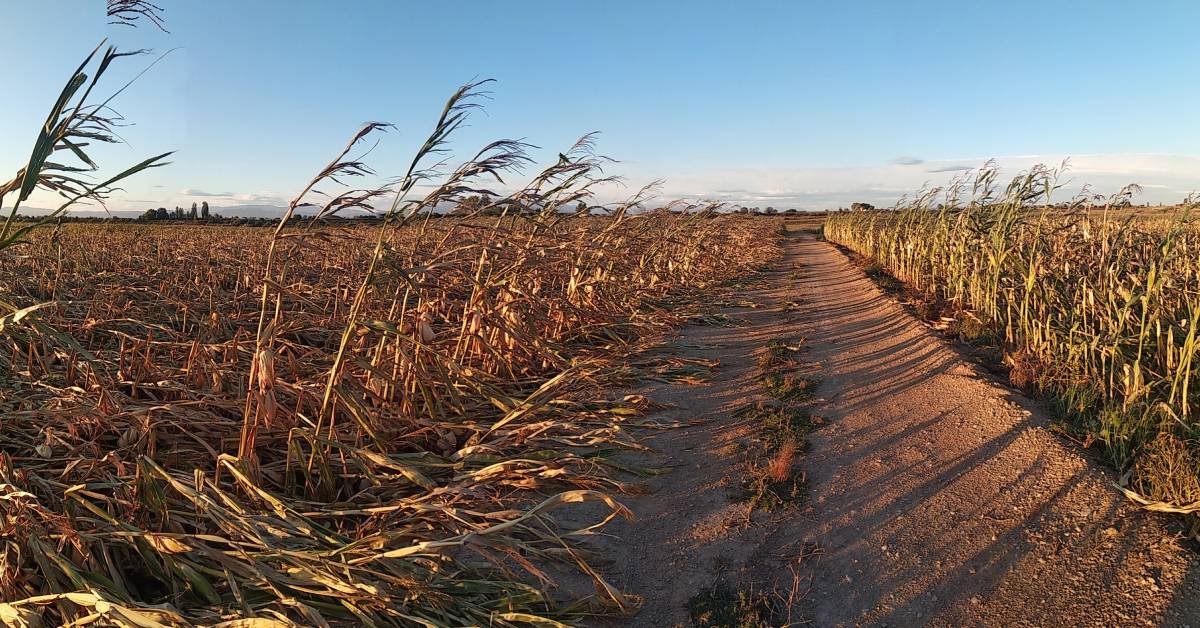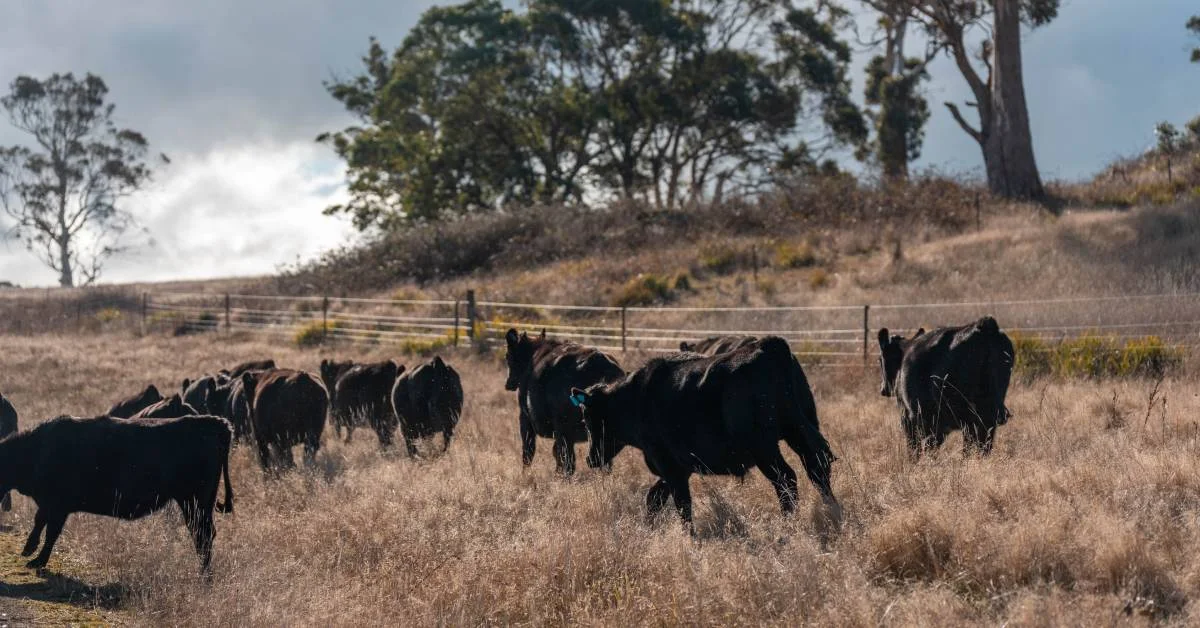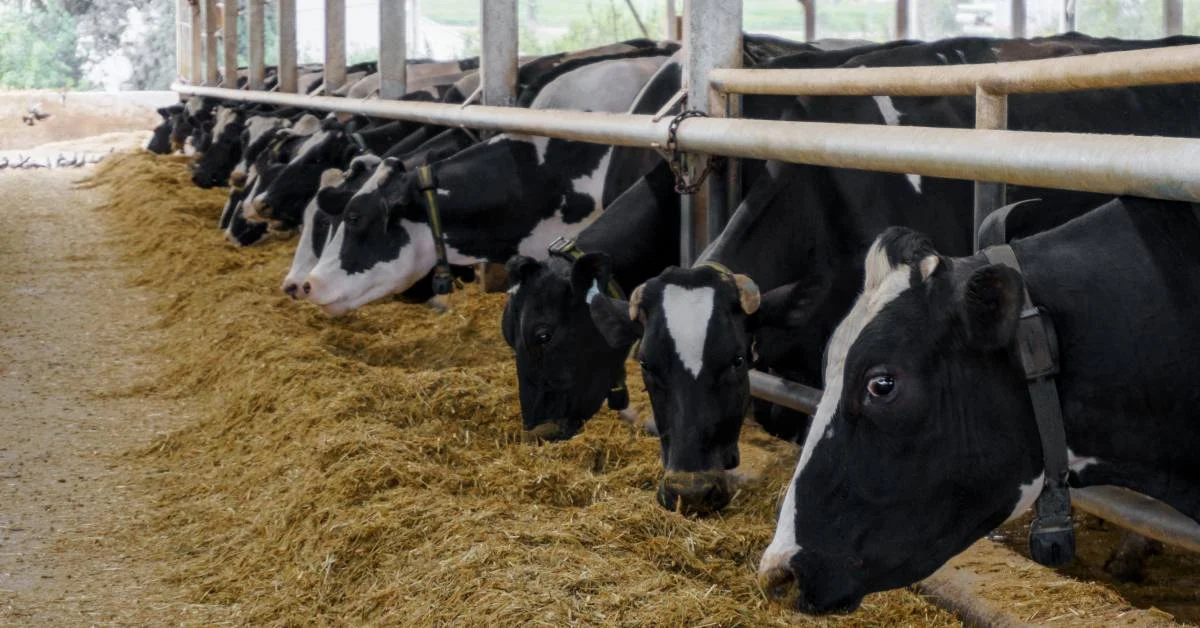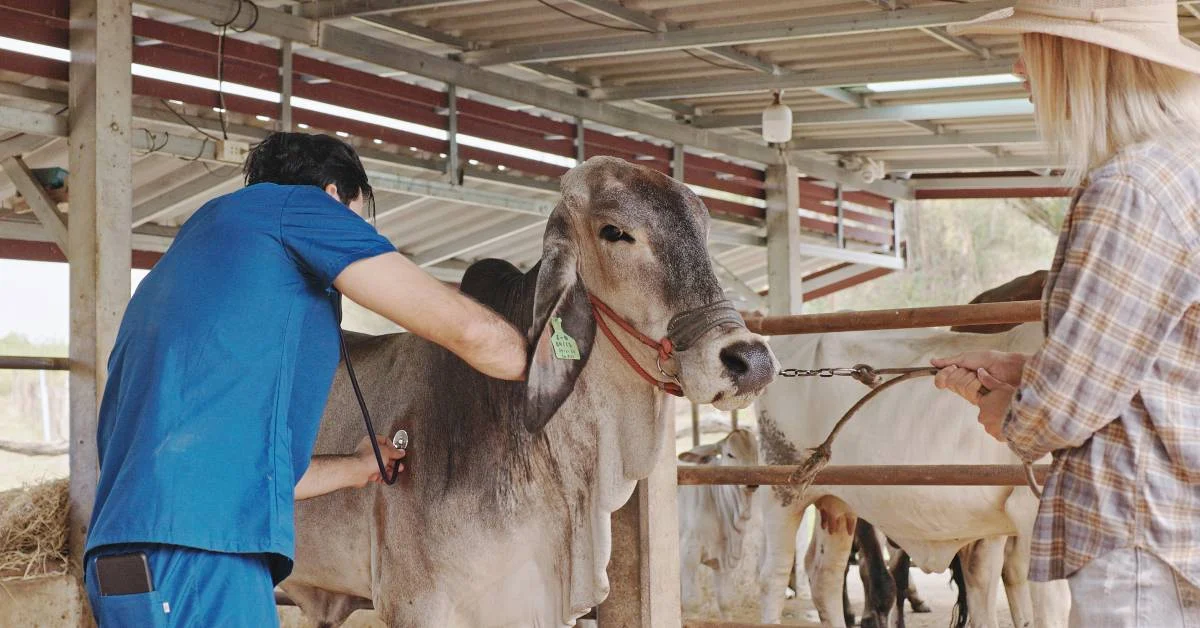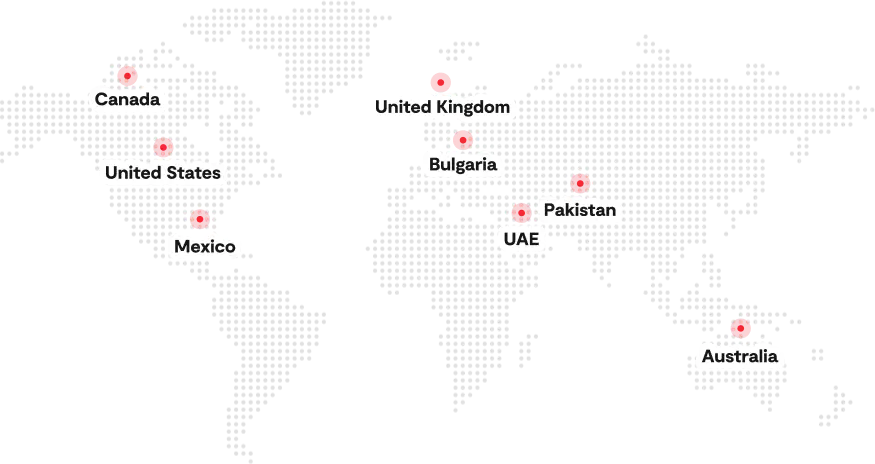Crop scouting is the first line of defense against yield loss because it helps farmers identify stress before it becomes irreversible. Most growers only react once visible damage appears, but by that stage the pathogen or pest has already spread. According to the FAO, up to 40 percent of crops are lost due to plant pests and diseases each year, which shows how costly delayed detection can be when early warning signals go unnoticed.
Crop scouting is more than looking at leaves during a routine walk across the field. It involves reading plant stress indicators, understanding soil and canopy conditions, and interpreting how pest pressure, moisture, or nutrient imbalance may evolve. When done consistently, crop scouting gives farmers better timing for intervention, lowers input costs, and improves season-long resilience.
In this blog, you will learn what professional-grade crop scouting includes, how to structure your scouting approach, what tools and technology now support field-level visibility, and how prevention-based management protects both yield and profitability. By the end, you will have a clear view of how modern crop scouting improves decision-making and keeps problems small before they become economic loss.
Why Crop Scouting Is Becoming Essential in Modern Agriculture
The rising importance of crop scouting is driven by economics as much as agronomy. Input costs for fertilizer, crop protection, and seed quality have steadily increased, which means every decision now carries a higher financial risk. When problems are identified too late, farmers apply more product, lose yield potential, and shorten the recovery window. Early scouting reduces waste by ensuring interventions are targeted and timed correctly, which directly strengthens crop management practices and helps optimize input use.
Climate volatility has also made growing conditions less predictable. Heat spikes, unseasonal rainfall, and shifting pest migration patterns raise uncertainty, so farms cannot depend on calendar-based spraying or intuition alone. Regular crop scouting gives real visibility into what is happening in the field at a biological level, helping detect common crop diseases at a stage when they can still be controlled with minimal cost and minimum chemical load.
Compliance pressures are another reason scouting is now mission-critical. Sustainability, residue thresholds, recordkeeping, and field traceability are all easier to meet when risk is identified early and documented. Stronger field data also acts as a buffer against crop failure, because emerging threats are contained before they scale into yield loss.
Modern operations increasingly rely on scouting to enable precision zoning, which helps separate low-pressure zones from high-pressure ones instead of treating the whole field the same. This cuts costs and improves per-acre profitability. For many growers, crop scouting has moved from a supporting activity to a core management discipline that protects margins and ensures consistent returns year after year.
Types of Crop Scouting Methods
Different farms rely on different approaches to crop scouting, but the most effective systems combine multiple methods to capture what the eye cannot always see. Each method serves a unique purpose, from surface-level observation to diagnostic investigation that reveals the underlying cause of stress.
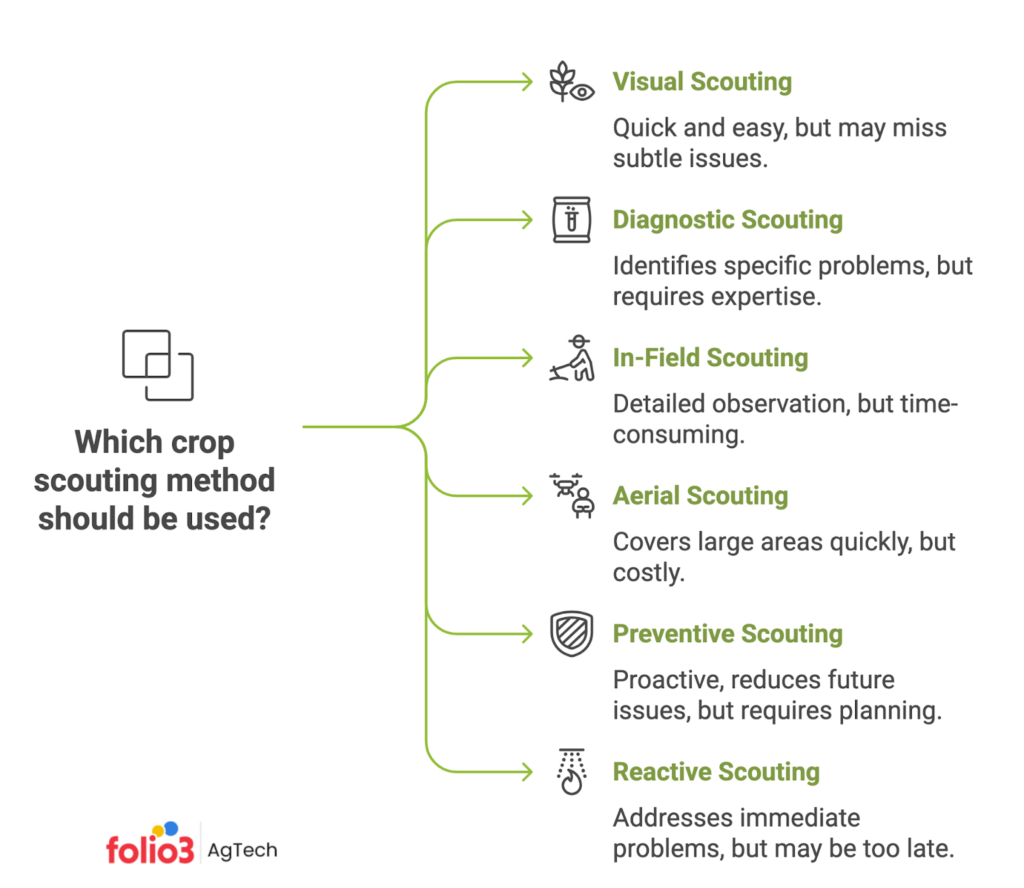
Visual Scouting vs Diagnostic Scouting
Visual scouting is the most traditional and widely used method. It focuses on visible plant symptoms such as chlorosis, spotting, wilting, or abnormal growth. While useful for early suspicion, it cannot always confirm the root cause of the issue. Diagnostic scouting goes deeper. It involves tissue sampling, soil testing, pest trapping, and in some cases lab-based pathogen confirmation. It is stronger for decision making because it connects symptoms to a measurable trigger, not just an assumption. In modern crop scouting, diagnostic validation is what prevents costly misapplication of inputs and creates the baseline data required for crop yield prediction using AI, where verified field intelligence powers forward-looking insights instead of reactive decisions.
In-Field Scouting vs Aerial Scouting
In-field scouting remains the backbone of field scouting programs because it allows hands-on observation. However, aerial scouting using drones or satellite imagery is now used to identify hotspots a farmer may not notice on foot. NDVI and canopy vigor maps help prioritize which areas to inspect first, saving time and catching issues earlier. Many operations use aerial scans for wide-field detection and in-field scouting for verification and treatment planning, which also supports sustainable crop production by ensuring inputs are applied only where needed instead of across the entire field. For practical use, satellites are typically 3–10 m resolution for trend spotting while drones provide 2–5 cm resolution for in-field diagnosis.
Preventive Scouting vs Reactive Scouting
Preventive scouting is calendar-based or growth-stage based monitoring that stays ahead of risk. It focuses on early signals before infection or infestation causes crop loss. Reactive scouting occurs after visible damage is already present. The most profitable systems rely on preventive scouting because it preserves yield potential and reduces chemical cost by catching pressure early. A preventive mindset turns crop scouting into a risk management discipline rather than a crisis response exercise, and it also creates better timing for precision fertilization for crop growth, since nutrient decisions are made with real field data instead of assumptions.
What to Look for During Crop Scouting
Effective crop scouting starts with recognizing early biological signals before they escalate into yield losses. The first area of attention is pest pressure indicators. Chewing damage, leaf mining, frass deposits, webbing, or population clustering on the underside of leaves all point toward emerging pest cycles. Tracking the life stage of the pest is equally important, because larvae and early instars are easier and cheaper to control than mature adults.
Beyond pests, fungal, bacterial, and viral symptoms all have different field signatures. Fungal diseases tend to appear as lesions, mildew, damping-off, or sporulation in humid conditions. Bacterial infections often create water-soaked patches, oozing, or angular leaf spots. Viral problems show up as mosaics, curling, stunting, or deformed fruit. The role of scouting is to separate suspicion from confirmation so growers can act early instead of waiting for widespread canopy damage.
Nutrient stress is another frequent misdiagnosis if visual symptoms are not evaluated in context. Yellowing could signal nitrogen stress, iron deficiency, compaction, or root disease. Field history, recent weather, and soil moisture patterns help differentiate nutritional stress from pathogen pressure. This is also where tissue sampling and soil readings support the field scout’s observations, making nutrition decisions more precise and cost-effective.
A structured growth-stage-based checklist keeps the scouting consistent. Young stands require more emphasis on emergence rates and seedling vigor, while later stages focus on canopy density, reproductive development, and grain or pod formation. Each growth window has its own vulnerability profile, so scouts look for timing-sensitive risks before they translate into yield penalties.
When this level of detail is applied consistently, crop scouting becomes a strategic driver to increase agricultural productivity, not just a defensive measure. Seeing symptoms early allows growers to intervene at the lowest cost, safeguard yield potential, and maintain healthier plants across the entire production cycle.
Scouting Frequency and Sampling Protocols
How often a field should be scouted depends on crop type, season, and existing pest or disease pressure. In general, early growth stages require more frequent checks because seedlings are more vulnerable and losses compound quickly if left unnoticed. As the crop matures, scouting shifts toward reproductive health and canopy integrity rather than emergence or stand counts.
A practical structure for frequency is:
- Normal conditions: once per week
- High-risk periods (humidity spikes, rapid temperature swings, or pest flight windows): twice per week
- Post-weather events (hail, prolonged rain, wind stress): immediate follow-up
Sampling density also matters because scattered checks can lead to blind spots. Most agronomists use:
- 8 to 10 sampling points in small fields
- A zigzag or W-pattern for uniform fields
- A zone-based approach for large or variable fields
- 5–10 plants per sampling unit depending on plant density
Weather-linked triggers are a major driver of cadence. Leaf wetness duration, overnight dew formation, and rapid humidity shifts favor fungal outbreaks, while hot and dry conditions extend pest migration cycles. These environmental cues help scouts move from calendar-based visits to risk-based visits, which improves timing and avoids unnecessary field passes.
Seasonality also changes scouting intensity. Early season is about establishment, mid-season is about stress monitoring, and late season scouting supports smart harvest planning by helping assess crop maturity, standability, and pre-harvest risks such as lodging or late-stage infection.
Structured sampling paired with weather awareness keeps scouting proactive instead of reactive, allowing growers to detect threats early while maintaining efficiency in labor and field time allocation.
Tools and Technologies Used in Crop Scouting
Crop scouting has evolved from simple field walks to a structured monitoring system powered by tools that improve accuracy, timing, and documentation. Traditional tools such as insect traps, measuring tapes, soil thermometers, and handheld magnifiers are still widely used because they help confirm what is physically present in the canopy or on plant tissue. Record books or digital notebooks are equally important for documenting changes over time and linking symptoms to weather events, planting dates, or field history.
Modern scouting now brings data layers into the process. Aerial technology using drones, multispectral cameras, and satellite imagery helps detect stress long before it becomes visible to the naked eye. NDVI, canopy temperature, and vegetation indices highlight hotspots so that scouts can prioritize which zones to inspect first. This improves efficiency while ensuring that no high-risk area is overlooked.
Mobile scouting apps and analytics platforms add another layer of value by converting observations into traceable field intelligence. Instead of relying on memory or scattered notes, digital logs standardize what is collected, where it was found, and when it was last checked. These tools also support geotagging, photo evidence, threshold alerts, and automated reports. Platforms like Folio3 AgTech integrate field-level data with aerial imagery and diagnostic records, giving growers a single hub to track risks, compare seasons, and quickly escalate interventions when needed.
For farms adopting digital workflows, these tools also enhance compliance, residue traceability, and sustainability reporting. They reduce subjectivity in scouting and help convert field observations into measurable action. When manual scouting tools and digital technologies work together, farmers get both biological clarity and data-backed visibility, which improves scouting precision and supports long-term resilience in crop production.
Common Mistakes Farmers Make in Crop Scouting
Looking at the Wrong Leaf Layer or Growth Stage
A common mistake is inspecting only the upper canopy and ignoring lower or mid-level leaf layers where early symptoms first appear. Many fungal and bacterial infections begin in shaded leaves or near the soil line, which means a surface-level walk misses the earliest risk signals. The same issue occurs when scouting is not matched to the correct growth stage. Each growth phase has a different vulnerability window, and when farmers check too early or too late, they lose the chance to intervene before damage escalates.
Not Recording Environmental Conditions
Scouting observations without weather context are incomplete. Humidity spikes, leaf wetness duration, and soil moisture are usually what trigger pathogen outbreaks, not just visible plant stress. When farmers fail to record wind direction, recent rainfall, nighttime temperatures, or cloudy-day persistence, they lose critical predictive information. This affects both risk forecasting and season-over-season benchmarking, which limits long-term improvements in increased agricultural productivity planning.
Reactive Scouting Instead of Preventive Scouting
Many growers still begin scouting only after visual stress is present, which is already a late stage response. Reactive scouting leads to heavier pesticide use, higher cost, and more severe yield penalties because pathogens have already been established. Preventive scouting builds baselines, allowing intervention before threshold levels are crossed. Professionals treat scouting as an early warning system, not a post-damage inspection. The shift from reactivity to prevention is often what separates profitable fields from those that struggle to recover.
When these mistakes are corrected, scouting becomes more predictive and less costly. The result is healthier fields, cleaner data, and better timing on agronomic decisions throughout the season.
How Folio3 AgTech Helps Growers Improve Scouting Accuracy and Field Decisions
Crop scouting is most effective when the field data is timely, structured, and connected back to farm-level decisions. This is where Folio3 AgTech’s crop scouting software strengthens operations. Instead of scattered notes or delayed reporting, the platform turns every observation into usable intelligence that improves scouting precision, treatment timing, and ROI on inputs.
The software enables real-time data capture from the field and links it to environmental context, location tags, and historical patterns. This helps growers understand whether a symptom is new, recurring, or trending toward threshold levels. By digitizing what would otherwise be handwritten logs, farm teams gain consistency, accountability, and performance traceability across the entire season.
Key Features Supported by the Platform
- Digital Scouting Maps
- Geo-tagged Field Observations
- Pest and Disease Threshold Tracking
- Growth Stage Monitoring
- Photo-based Documentation
- NDVI and Vegetation Index Integration
- Sampling Templates
- Multi-farm and Multi-block Visibility
- Offline Field Mode
- Reporting and Export
The platform also helps close the gap between scouting and execution. Instead of scouting data sitting unused, growers can trigger follow-up actions faster, verify treatment effectiveness, and plan field-level interventions before stress becomes crop loss. This improves timing, reduces unnecessary spraying, and protects yield potential. Since all records are stored over time, Folio3 AgTech also builds a season-on-season intelligence layer. That means a symptom that appears today can be compared to past conditions, weather triggers, or soil patterns, making future decisions more predictive and less reactive.
In short, Folio3 AgTech equips farms with the tools to scout better, act faster, and manage risk proactively. This creates a direct bridge into improved field profitability, which we will now connect in the conclusion.
Conclusion
Effective crop scouting is no longer a supporting task but a profitability driver in modern farming. When issues are caught early, growers protect yield potential, avoid unnecessary chemical cost, and maintain long-term soil and plant health. Scouting also creates the information base required for better planning, smarter zoning, and more confident field decisions.
The farms that invest in structured scouting systems consistently outperform those that rely on reactive responses. Precision, not guesswork, is what shields margins against rising input costs and unpredictable weather risk. As agriculture becomes more data-aware, scouting has become the front line of risk management.
Digital tools strengthen this even further by turning observations into trends and decisions, closing the loop between detection and action. When scouting becomes continuous, organized, and insight-driven, growers gain not only healthier crops but more resilient operations over time.
FAQs
What Is The Meaning Of Crop Scouting?
Crop scouting is the practice of regularly monitoring fields to identify pests, diseases, nutrient stress, or other plant health issues early. It helps farmers understand real field conditions and make timely management decisions before yield is affected.
How Much Does Crop Scouting Cost Per Acre?
Costs vary based on service type, crop, and level of diagnostic detail, but most professional scouting programs range between 5 to 15 USD per acre. Farms relying on technology-based scouting or bundled agronomy services may pay more for analytics and reporting.
What Does Scouting Mean In Plants?
In plants, scouting refers to systematic observation of crops to detect abnormalities, pest presence, disease symptoms, or stress indicators. It is a preventive approach that allows farmers to intervene early instead of waiting for visible damage or crop loss.
What Are The 5 Crop Diseases?
Five commonly known crop diseases are late blight, powdery mildew, bacterial wilt, rust, and leaf spot. These diseases affect various crops and can spread quickly without early detection through structured crop scouting programs.

